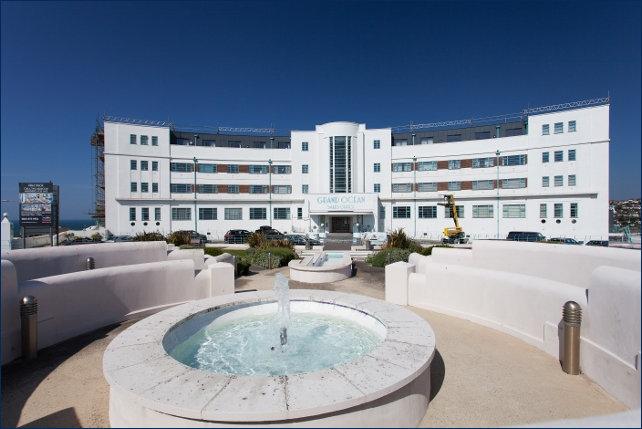The Ocean Hotel - Saltdean
Home Page / Art Deco Home / Open Air Lidos
The Ocean Hotel 1938 to the Present
Many years ago, after seeing the Poirot episode entitled 'Double Sin' I started my search for the great white curved hotel, which at the back of my mind was very familiar. To cut a long story short and avoid repetition (which apparently is a symptom of 'old age') I shall direct you to the page where our many and varied visits to the Ocean and Midland Hotels are already chronicled. I knew the Midland of course because I studied at Lancaster Art School and we, the students, were all frequent visitors to Morecambe from Friday night through to Sunday afternoon. In those days it was Sun, Sand, Sangria, Beach and this big white place! Many years later as we joined the 'Friends of the Midland' to fight for the survival of the Midland we were introduced to its 'lookalike' during a historical slideshow presented to the group at a Midland 'weekend away' while it was still potentially habitable (so long as it didn't rain and there weren't any strong winds)! I remember being mildly interested and retained the knowledge that a hotel, called the Ocean, with similar features had somehow been connected to Butlins. I'm glad I retained that memory because it now means that the Ocean has become a cherished memory and addition to my website of personal interests.
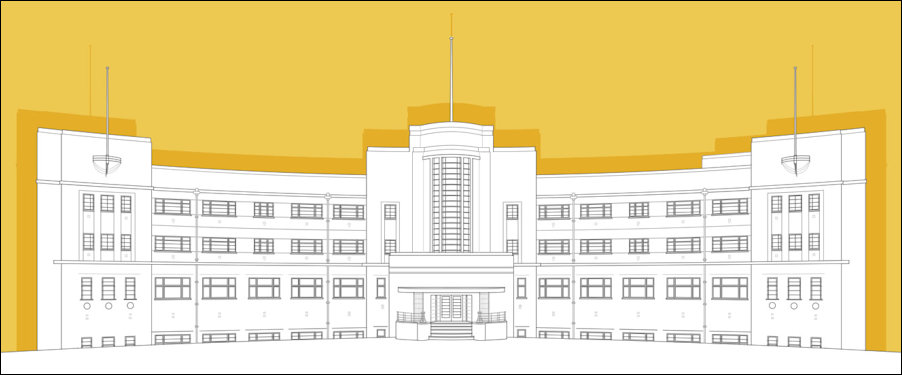
The Ocean Hotel given the familiar 'Modernist Britain' architectural flourish
Standing on Longridge Avenue in Saltdean, at its junction with Wicklands Avenue is the former (Grand) Ocean Hotel. The Ocean Hotel was built in 1938 and was designed by the architect Richard William Herbert Jones, who also designed Saltdean's Grade II*-listed Lido and residential properties Teynham House, Curzon House and Marine View along Chichester Road East and Marine Drive.
The hotel was built by the Ocean Hotels Ltd at a cost of £200,000. Designed in the Streamlined Moderne style, the hotel extends over three main storeys above a basement storey. The frontage of the hotel is concave in form, with a symmetrical design, featuring ranges and outer wings either side of a central core. The ground floor level of the hotel houses the main public rooms of the hotel, including the ballroom. The second and third storeys are given over to hotel accommodation.
The central core of the hotel comprises three bays, with the central bay occupied by a large, full height window to the second and third storeys illuminating the hotel's spiral staircase. At the ground floor there are double doors opening onto the hotel foyer, beneath a curved canopy roof. The central bay terminates with a raised parapet, and is topped with a central flagpole. Read more here
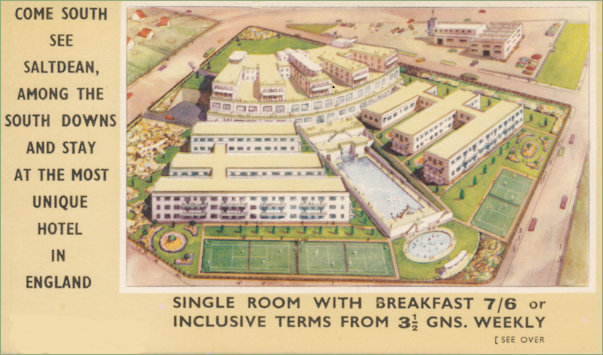
Postcards of the hotel advertising its tariffs which were more comprehensively listed on the reverse
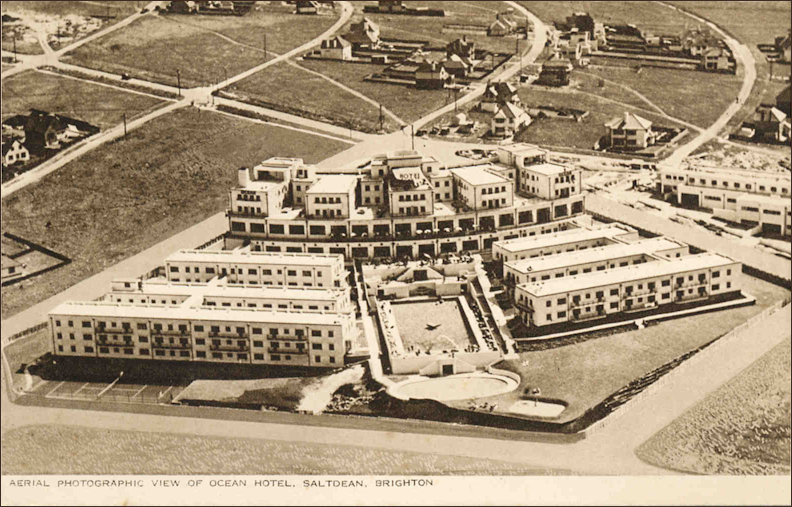
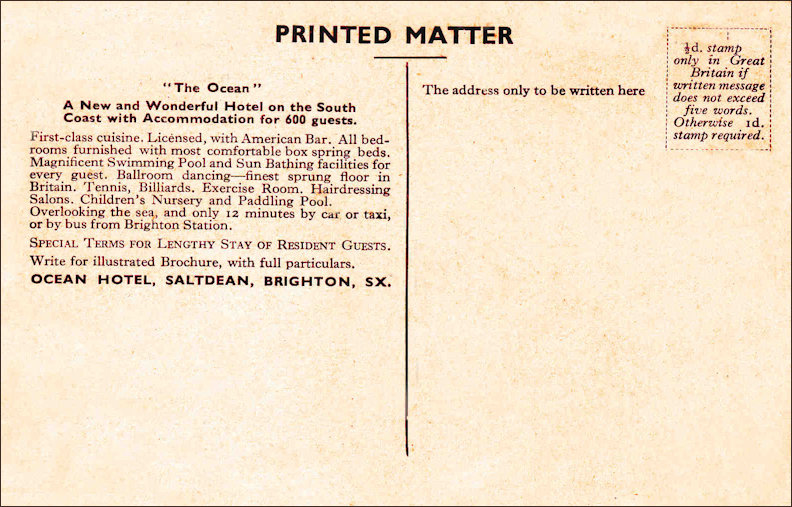
Postcards of the hotel advertising its tariffs which were more comprehensively listed on the reverse - from my private collection. Grateful thanks to author/historian Douglas d'Enno for providing the scans of the lower example.
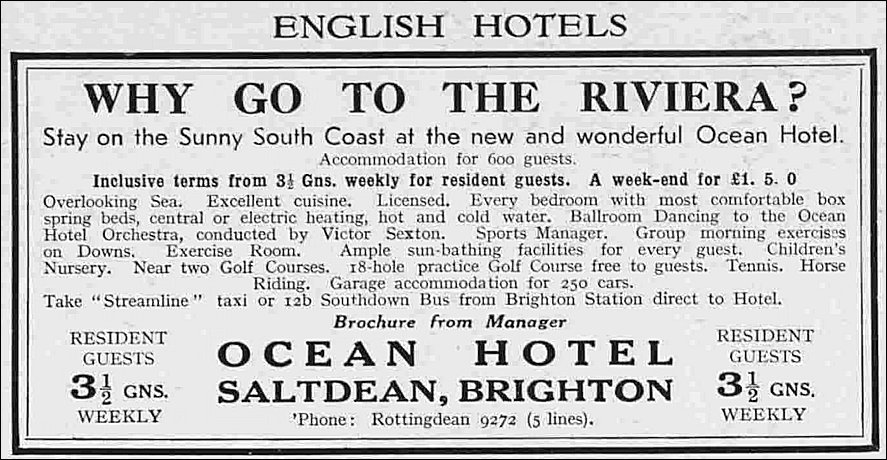
This advert appeared regularly throughout 1938 even in the winter months - sourced from the British Newspaper Archive (BNA)
1938 - Opening Year
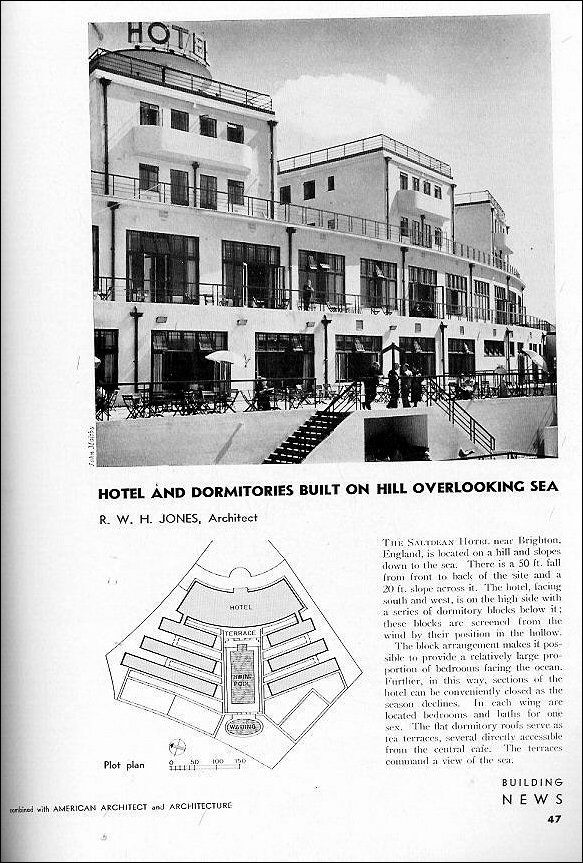
Trade Magazine 'Building News combined with American Architect and Architecture' gives an overview of the new Ocean Hotel
The Saltdean Hotel near Brighton, England is located on a hill and slopes down to the sea. There is a 50ft fall from front to back of the site and a 20ft slope across it. The hotel facing south and west, is on the high side with a series of dormitory blocks below it: these blocks are screened from the wind by their position in the hollow. The block arrangement makes it possible to provide a relatively large proportion of bedrooms facing the ocean. Further, in this way sections of the hotel can be conveniently closed as the season declines. In each wing are located bedrooms and baths for one sex. The flat dormitory roofs serve as tea terraces, several directly accessible from the central café. The terraces command a view of the sea.
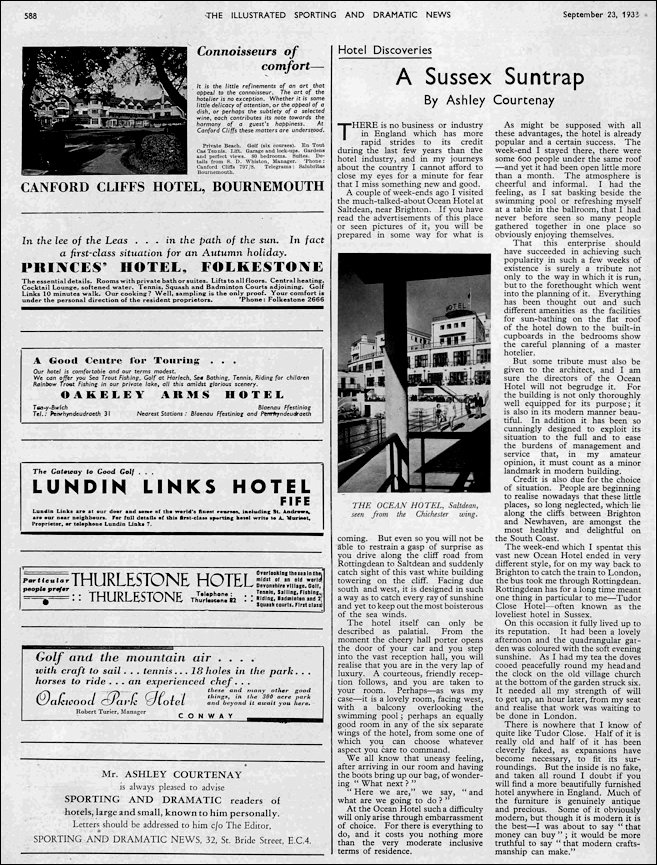
From the 'Illustrated Sporting and Dramatic News' on Friday, 23rd October 1938 comes this comprehensive review by Ashley Courtenay - sourced from the British Newspaper Archive (BNA)
A Sussex Suntrap by Ashley Courtenay
There is no business or industry in England which has more rapid strides to its credit during the last few years than the hotel industry, and in my journeys about the country I cannot afford to close my eyes for a minute for fear that I miss something new and good. A couple of week-ends ago I visited the much-talked-about Ocean Hotel at Saltdean, near Brighton. If you have read the advertisements of this place or seen pictures of it, you will be prepared in some way for what is coming. But even so you will not be able to restrain a gasp of surprise as you drive along the cliff road from Rottingdean to Saltdean and suddenly catch sight of this vast white building towering on the cliff. Facing due south and west, it is designed in such a way as to catch every ray of sunshine and yet to keep out the most boisterous of the sea winds. The hotel itself can only be described as palatial. From the moment the cheery hall porter opens the door of your car and you step into the vast reception hall, you will realise that you are in the very lap of luxury. A courteous, friendly reception follows, and you are taken to your room. Perhaps as was my case it is a lovely room, facing west, with a balcony overlooking the swimming pool perhaps an equally good room in any of the six separate wings of the hotel, from some one of which you can choose whatever aspect you care to command.
We all know that uneasy feeling, after arriving in our room and having the boots bring up our bag, of wondering "What next" "Here we are," we say, "and what are we going to do?"
At the Ocean Hotel such a difficulty will only arise through embarrassment of choice. For there is everything to do, and it costs you nothing more than the very moderate inclusive terms of residence. As might be supposed with all these advantages, the hotel is already popular and a certain success. The week-end I stayed there, there were some 6oo people under the same roof and yet it had been open little more than a month. The atmosphere is cheerful and informal. I had the feeling, as I sat basking beside the swimming pool or refreshing myself at a table in the ballroom, that I had never before seen so many people gathered together in one place so obviously enjoying themselves.
That this enterprise should have succeeded in achieving such popularity in such a few weeks of existence is surely a tribute not only to the way in which it is run, but to the forethought which went into the planning of it. Everything has been thought out and such different amenities as the facilities for sun-bathing on the flat roof of the hotel down to the built-in cupboards in the bedrooms show the careful planning of a master hotelier. But some tribute must also be given to the architect, and I am sure the directors of the Ocean Hotel will not begrudge it. For the building is not only thoroughly well equipped for its purpose; it is also in its modern manner beautiful. In addition it has been so cunningly designed to exploit its situation to the full and to ease the burdens of management and service that, in my amateur opinion, it must count as a minor landmark in modern building. Credit is also due for the choice of situation. People are beginning to realise nowadays that these little places, so long neglected, which lie along the cliffs between Brighton and Newhaven, are amongst the most healthy and delightful on the South Coast.
The week-end which I spent at this vast new Ocean Hotel ended in very different style, for on my way back to Brighton to catch the train to London, the bus took me through Rottingdean. Rottingdean has for a long time meant one thing in particular to me Tudor Close Hotel often known as the loveliest hotel in Sussex. On this occasion it fully lived up to its reputation. It had been a lovely afternoon and the quadrangular garden was coloured with the soft evening sunshine.
As I had my tea the doves cooed peacefully round my head and the clock on the old village church at the bottom of the garden struck six. It needed all my strength of will to get up, an hour later, from my seat and realise that work was waiting to be done in London. There is nowhere that I know of quite like Tudor Close. Half of it is really old and half of it has been cleverly faked, as expansions have become necessary, to fit its surroundings. But the inside is no fake, and taken all round I doubt if you will find a more beautifully furnished hotel anywhere in England. Much of the furniture is genuinely antique and precious. Some of it obviously modern, but though it is modern it is the best I was about to say that money can buy it would be more truthful to say that modern craftsmanship can make." Hotel Discoveries THE OCEAN HOTEL Saltdean, seen from the Chichester wing.
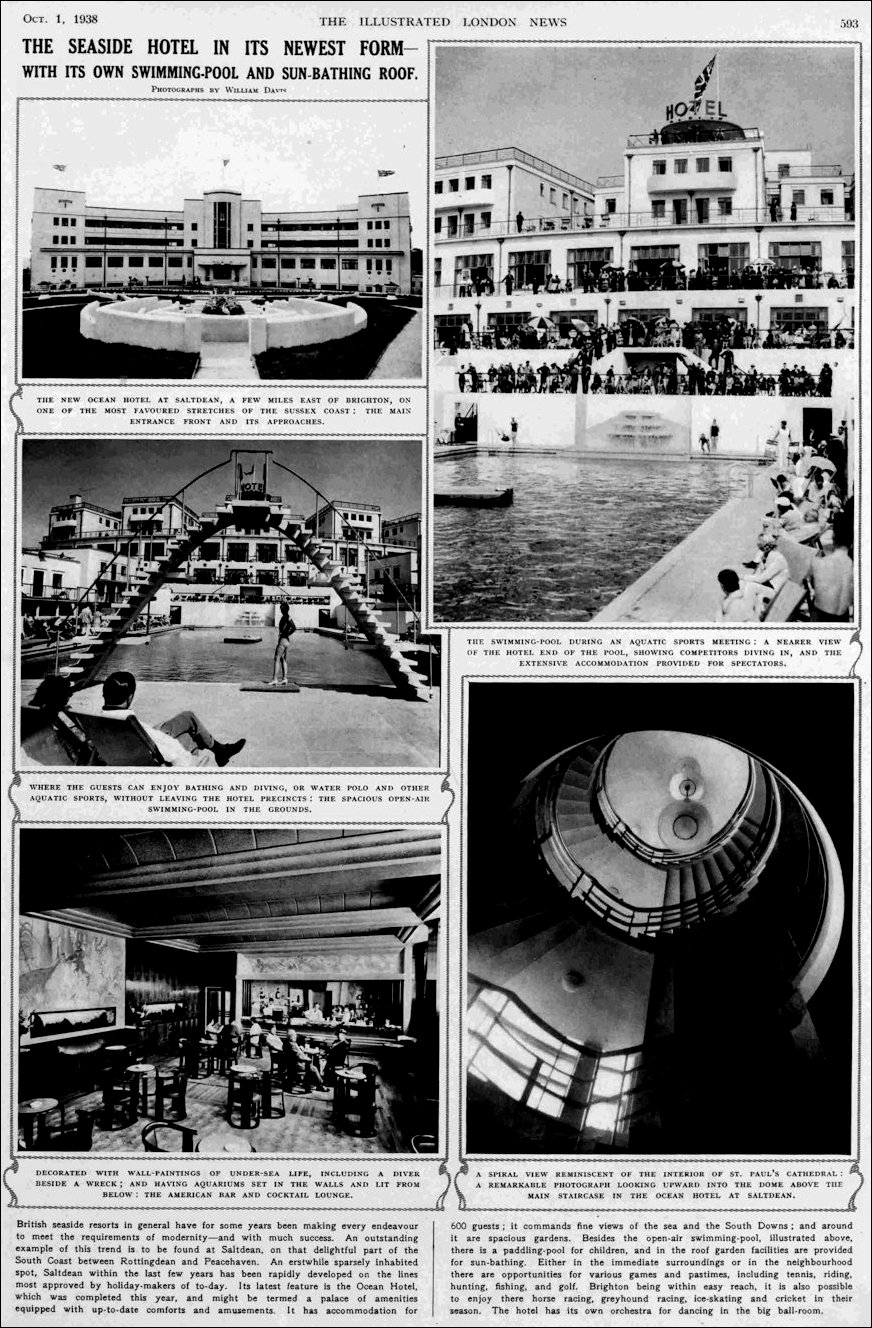
From the London Illustrated News, dated Saturday, 1st October 1938 detailing the interior of the Ocean Hotel in its opening year - sourced from the British Newspaper Archive (BNA)
A REMARKABLE PHOTOGRAPH LOOKING UPWARD INTO THE DOME ABOVE THE MAIN STAIRCASE IN THE OCEAN HOTEL AT SALTDEAN. DECORATED WITH WALL-PAINTINGS OF UNDER-SEA LIFE, INCLUDING A DIVER BESIDE A WRECK AND HAVING AQUARIUMS SET IN THE WALLS LIT FROM BELOW'
British seaside resorts in general have for some years been making every endeavour to meet the requirements of modernity—and with much success. An outstanding example of this trend is to be found at Saltdean, on that delightful part of the South Coast between Rottingdean and Peacehaven. An erstwhile sparsely inhabited spot, Saltdean within the last few years has been rapidly developed on the lines most approved by holiday-makers of to-day. Its latest feature is the Ocean Hotel, which was completed this year, and might be termed a palace of amenities equipped with up-to-date comforts and amusements. It has accommodation for 600 guests ; it commands fine views of the sea and the South Downs ; and around it are spacious gardens. There is a paddling-pool for children, and in the roof garden facilities are provided for sun-bathing. Either in the immediate surroundings or in the neighbourhood there are opportunities for various games and pastimes, including tennis, riding, hunting, fishing, and golf. Brighton being within easy reach, it is also possible to enjoy there horse racing, greyhound racing, ice-skating and cricket in their season. The hotel has its own orchestra for dancing in the big ball-room.
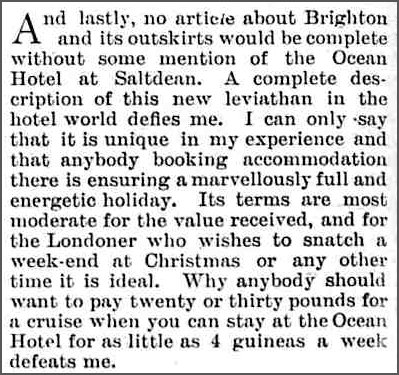
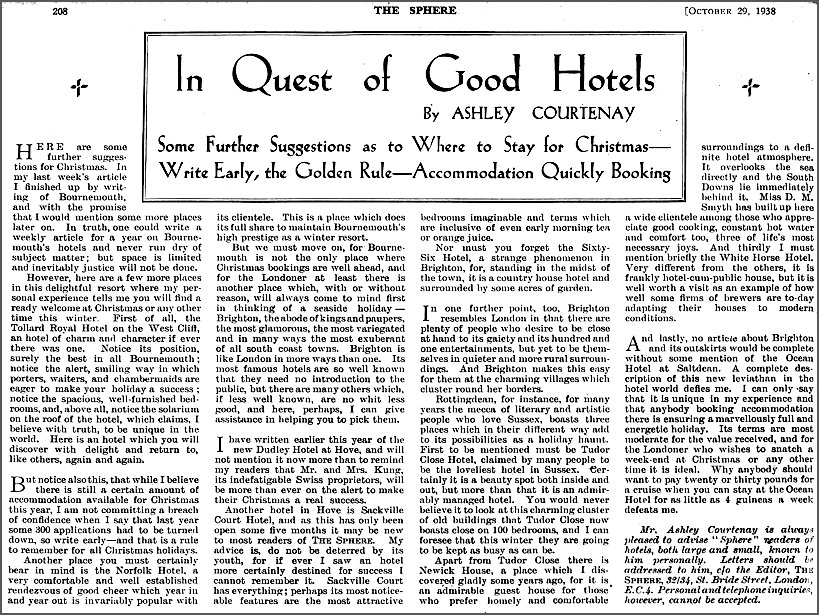
The Sphere, dated 29th October, 1938 extolling the virtues and writing a review for the 'Ocean Hotel' shortly after it's opening in July, 1938 sourced from the British Newspaper Archive (BNA)
The Butlins Years 1952 - 1999
The earliest postcard image I can find of the Butlins 'Reception Hall' which happily was left relatively unscathed.
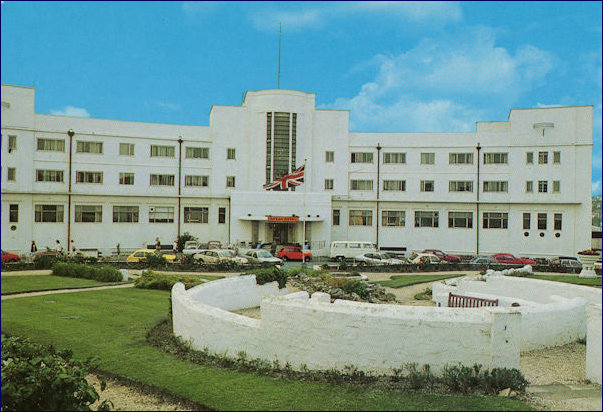
Opened in 1938 the Ocean Hotel occupied a site of around 4 acres with 344 bedrooms and a dining hall that could seat 300 people. It consisted of a main building shaped like a crescent which contained the whole of the public rooms and some of the bedrooms, and there were six other buildings which contained bedrooms and bathrooms only. The hotel was so arranged that during the winter season the six detached blocks could be closed down and the main building, with its 130 bedrooms, run as a separate hotel. An outdoor swimming pool (later enclosed) was built between the buildings. During the war the hotel was taken over by the Auxiliary Fire Service and later became a fire service college which was officially opened by the then Home Secretary Herbert Morrison. It was used throughout the war and was not handed back until 1952 when the lease was acquired by Billy Butlin for £250,000. Its doors were opened as a holiday centre again on 2 May 1953, after an army of workmen had spent the previous six months restoring the near-derelict building. It soon became popular with honeymooners and Billy Butlin later said the hotel was one of the best investments he'd ever made. Sold in July 1999 to the Grand Hotel Group the hotel remained open until January 2005. Read/see more here
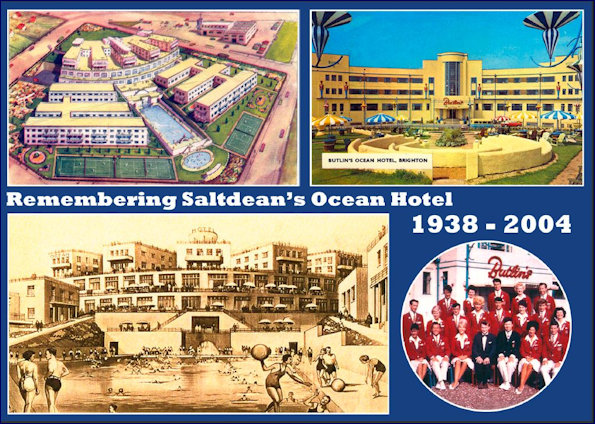
Much of the historical content of this page would not have been possible without the invaluable help of the very patient historian and author Douglas d'Enno who in his own words wrote to me that "I'm pleased you were able to make use of the multiview postcard I produced together with a local photographer bidding farewell to the Ocean Hotel. For the record, her name is Colette Langton." My own version of a similar card that I produced for the Midland Hotel was inspired by this tribute. - Many thanks Douglas
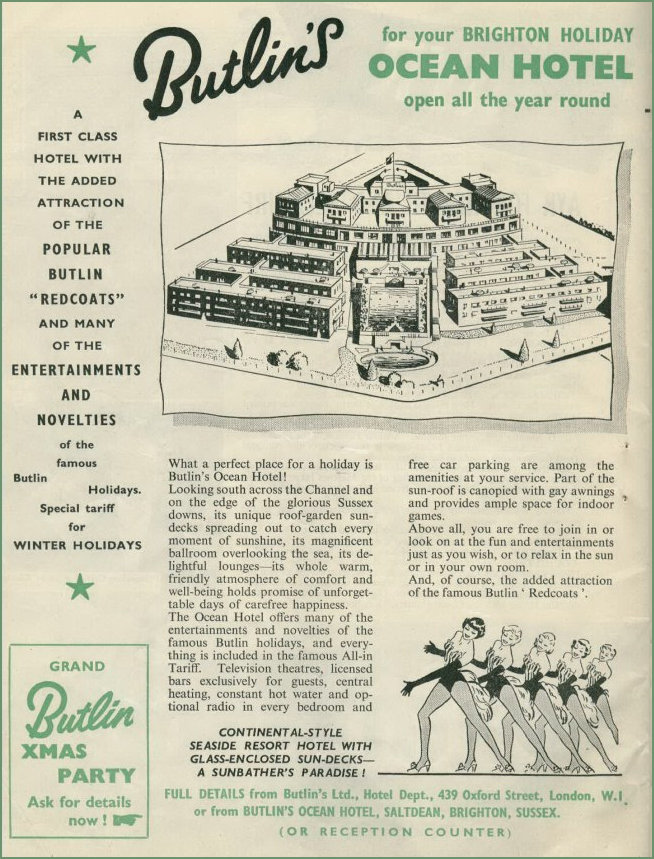
1993 - Starring in 'The Jewel Robbery at The Grand Metropolitan' a 'Poirot' mystery
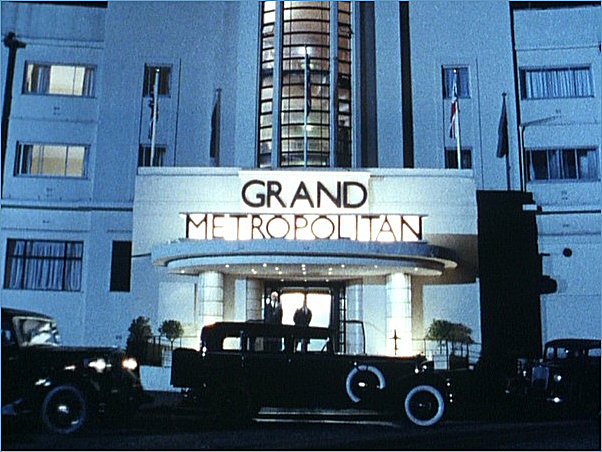
Night view taken from a screen shot of the episode
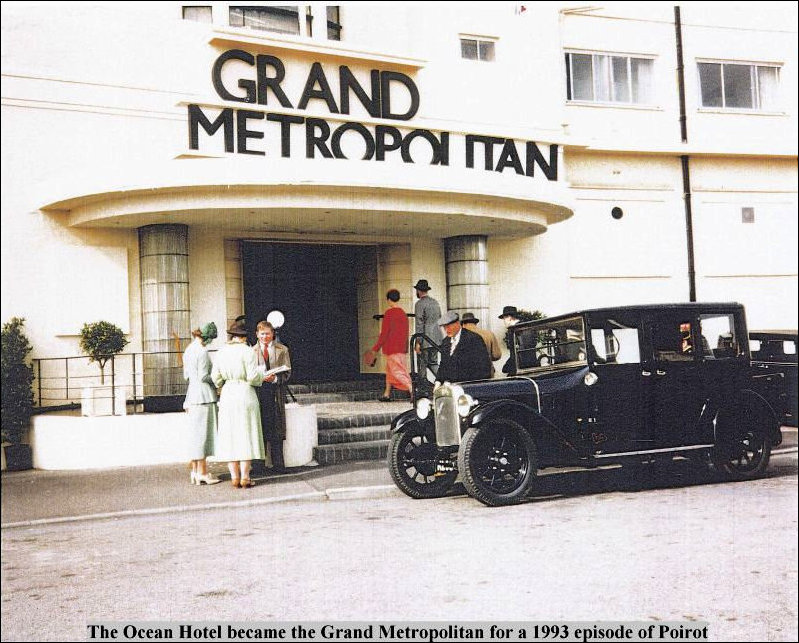
A publicity still issued by (the former) Granada Television and the BBC for the 1993 episode in the 'Poirot' series entitled 'The Jewel Robbery at the Grand Metropolitan'
19th August 2017 - Glamour Hotels
The glamorous hotels that have been converted into flats and offer grand ballrooms and basement pools
By Graham Norwood For The Daily Mail | |
Bob Dylan, Janis Joplin and Leonard Cohen all, famously, lived in New York’s bohemian Chelsea Hotel. It’s now undergoing refurbishment and set to re-open to guests next year. But these days you can check into hotels, even those with an illustrious past, full-time as an owner because many are being turned into houses.
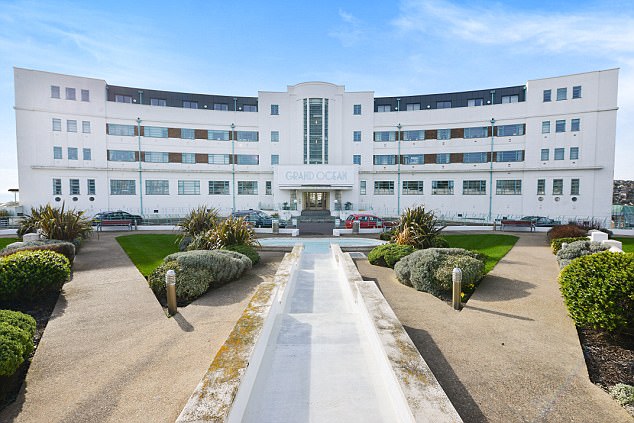
Art Deco masterpiece: The Grand Ocean Hotel at Saltdean, near Brighton
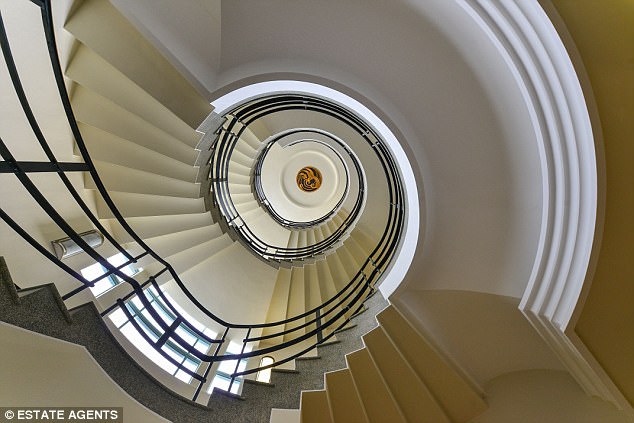
Scenic stairway: The Grand Ocean Hotel's magnificent spiral staircase - images courtesy & © of the Estate Agents via the Daily Mail
Perhaps the best known conversion in recent times has been the Art Deco Grand Ocean Hotel at Saltdean, near Brighton. When it opened in 1938, it played host to royalty and was later a war-time fighter pilot base, a branch of Butlin’s and appeared in an episode of Agatha Christie’s Poirot — and now it has become 183 apartments. Leaders estate agents has two, two-bedroom flats for sale there from £289,000. Read more here
20th January 2010 - The Grand Unveiling
Invitations were sent out to prospective buyers :
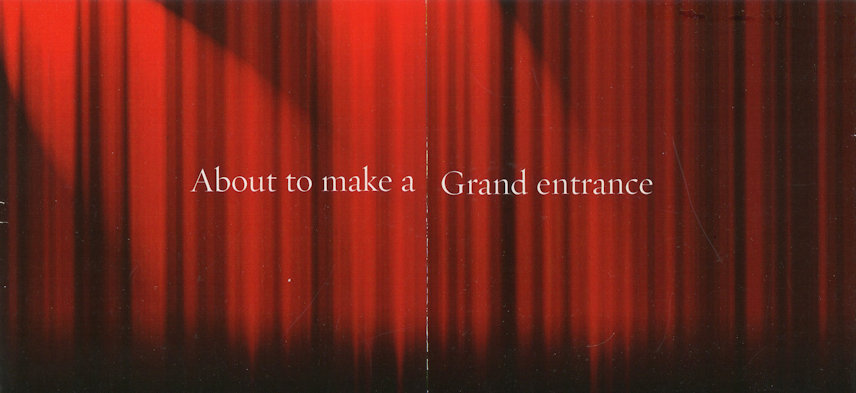
The front of the foldover invitation tantalisingly showing, in time honoured tradition, a closed curtain
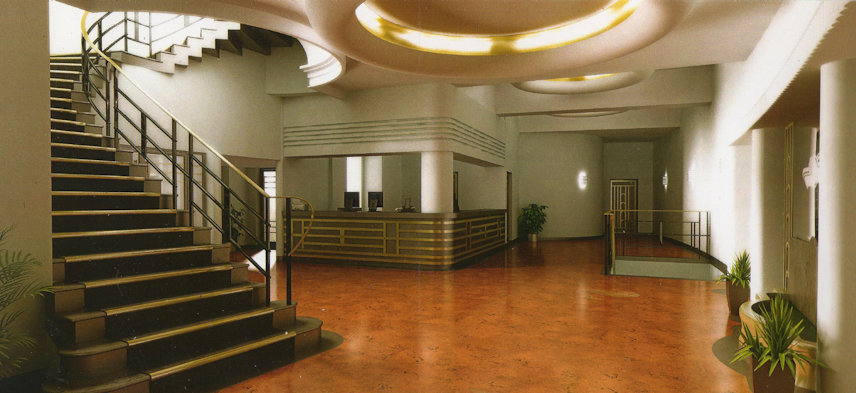
By opening the foldover tabs, the fully refurbished lobby and stairwell are revealed
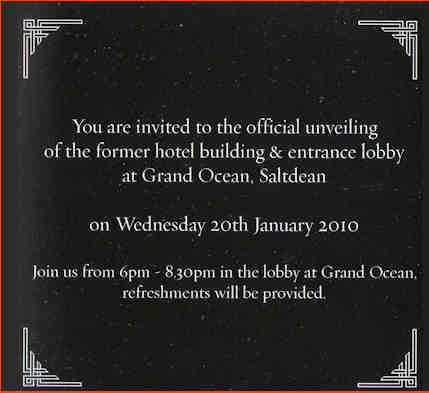
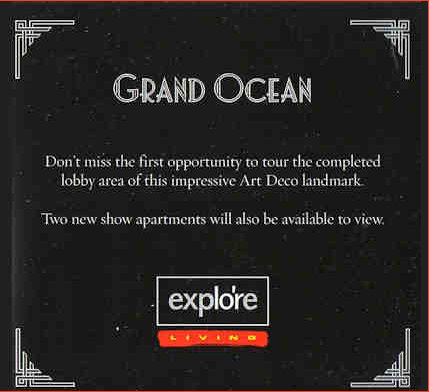
The side tabs reveal the details of the opening tour
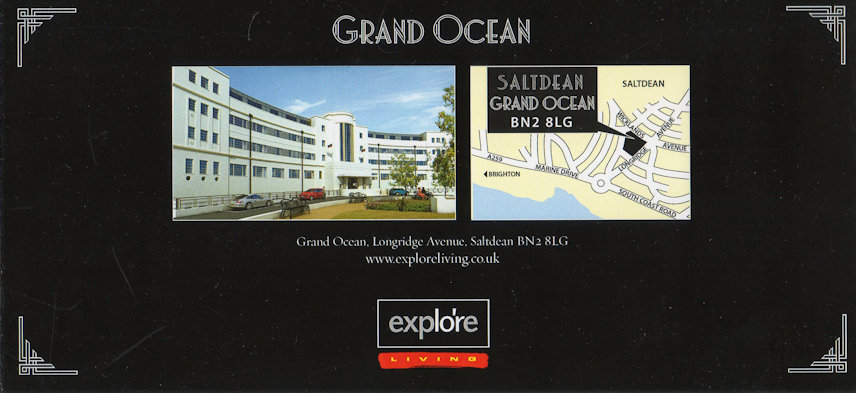
The reverse promotes the exterior of the hotel with a handy map showing how to get there
More sales blurb here - "A slice of modern history awaits the occupants of the Grand Ocean development in Saltdean, Sussex, a collection of 280 one and two-bedroom apartments in a refurbished 1930s art deco hotel. Once owned by Butlins, the property was also used to film Poirot episode "The jewel robbery at the Grand Metropolitan" in 1993. Buy an apartment from £180,000, from Explore Living."
Check into the Ocean
Excellent article by the RPS Group - I love the punchy introduction!

No wonder there's a song about Bette Davis' 'eyes'
From 2005 until very recently it was empty, and looking considerably like the aftermath of an out-of-hand party. Between 1953 and 1999 it was a lively Butlins where Tarbuck tickled the guests’ humour as a redcoat, followed by a short turn with the Grand Hotel Group. In 1938, however, the smashed windows were brightly lit and the empty halls echoed with fashionable personages including the film star Bette Davis. Today is the grand re-opening of the Ocean Hotel, Saltdean – restored and rejuvenated as classic deco-style apartments.
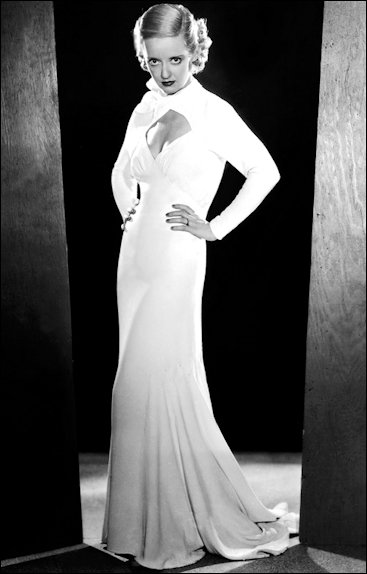
Oh really? - Bette Davis at the Ocean - might she have looked like this making a grand entrance into the dining area? I do hope so (although debunked by historian Douglas d'Enno in the Sussex Life article) - image courtesy & © the Everett Collection
The Grade II listed hotel is a magnificent piece of Art Deco architecture: the curving wave of a white stucco frontage block with cast glass columns framing the entrance, facing a triangular garden with ornamental water feature. Located in the seaside resort of Saltdean, some five miles to the east of Brighton, the building was designed and built between 1938 and 1939, by Richard H Jones for Ocean Hotels Ltd – an arm of Saltdean Estate Company that had built the Saltdean Lido and developed the adjoining land for housing. The design of the hotel was influenced by nearby De La Warr Pavilion, which had been built in 1935 to the design of Eric Mendelsohn.
When completed in 1939 it provided accommodation for 600 guests across six buildings, with a built-in wardrobe, lavatory, basin, house telephone and electric fire in each of its 411 bedrooms. Public rooms included a 120ft long restaurant and lounge with American-style bar, and dance floor in the main hotel, and staff sleeping quarters were provided above a 150 car garage space. Read more here
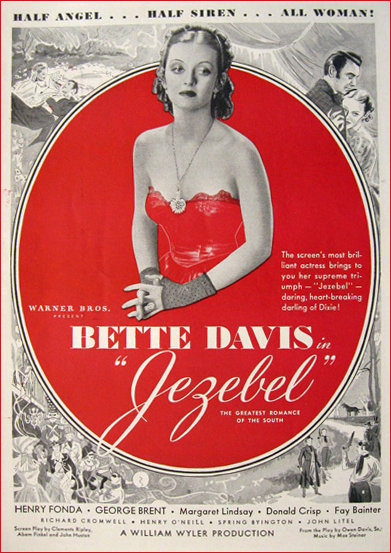
And coincidentally (or is it) Bette Davis' film 'Jezebel' was released in 1938
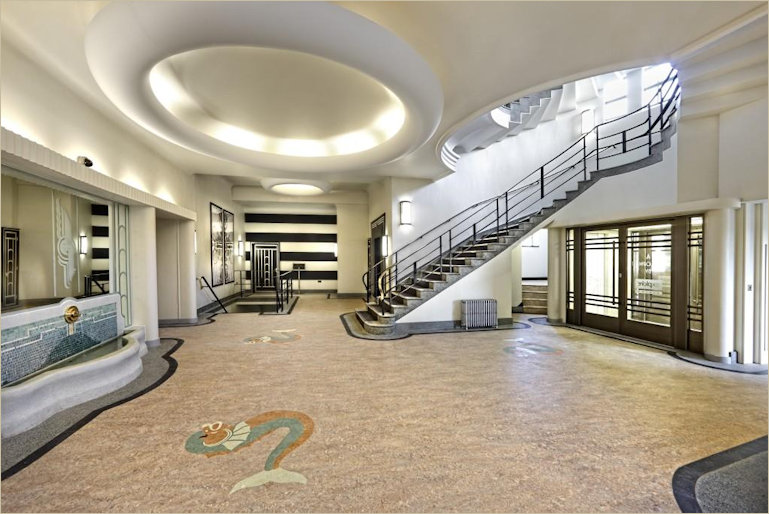
The beautifully restored lobby which could be graced by any film star - the original features have been enhanced and kept true - a real 'labour of love' or 'true feel' by the designers.
Repairs, Refurbishment And Water Ingress By The Sea
Kemper-System have provided a very thorough and comprehensive resumé of the work needed to refurbish the Ocean back to its grand former self and we thank them for doing such an excellent job.
The Ocean Hotel restored to its majestic self thoroughly deserving the return of the 'Grand' tag - image courtesy & © of Kemper-System
From the Kemper web-site : You only need to see a picture of The Grand Ocean Hotel in Saltdean, near Brighton, in its heyday to capture a glimpse of a bygone era of glamorous seaside elegance and affordable luxury in surroundings that epitomised contemporary design. The Grade II listed building first opened on a four-acre site in 1938 with 344 bedrooms and a dining hall that could seat 300. Its crescent-shaped white façade with pillars at each end and a bulbous central pillar makes it a classic of Art Deco architectural design.
Now the central building from which a development of luxury apartments takes its name, this costal landmark has had a varied history, which includes being requisitioned by the Auxiliary Fire Service during World War II, used as a Fire Service college after the war and becoming a popular honeymoon destination in the 1950s after it was acquired, repaired and re-opened by holiday camp pioneer, Billy Butlin in 1953. While Butlins sold the iconic hotel in 1999, it remained open as a hotel until 2005 when planning permission was granted to convert it into luxury apartments. The consent also included construction of an additional four new build apartment blocks within the grounds. Read more here
Ocean Heritage
On Sunday, 17th July, Suzanne Keep, the daughter of the lido's architect, R.W.H Jones, visited Saltdean Lido and the Ocean Hotel. She last visited as a child in 1938, when she stayed at the hotel with her family for its grand opening night. One of her fondest memories of that evening is of her and her sister sliding down the brass bannister of the hotel's spiral staircase, for which they 'got into a lot of trouble'.
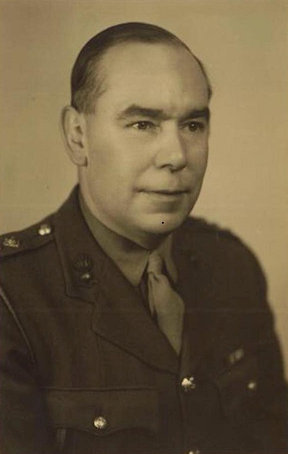
R.W. Jones - Architect
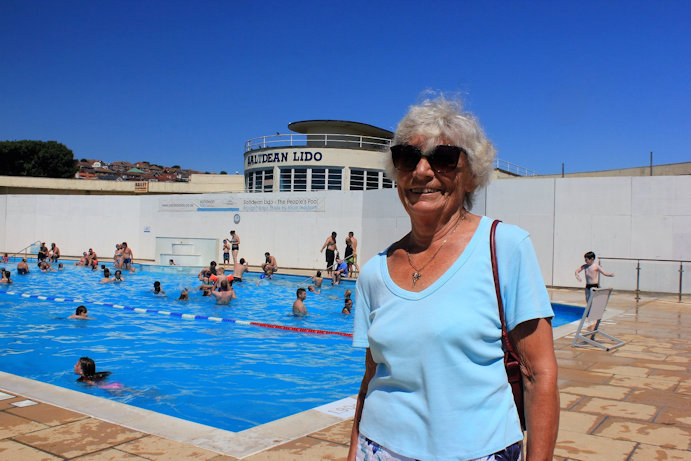
Suzanne Keep - R.W. Jones daughter
Suzanne said: 'My father was always smiling, he was a traditional family man. He took his work very seriously, and never brought it home. His team of architects worked right up until the outbreak of the Second World War, at which point they closed up and went to join the fight ... At home he was a fun man, and regularly took us on holiday. He was also a keen swimmer and trained to swim The Channel. He was my hero'.
Suzanne also said today: 'I find it incredible that so many people have worked so hard to try to restore Saltdean Lido. My father would have been really pleased'.
It's fitting that a dedicated family man, 'who was always smiling', designed one of the UK's most popular and imaginative lidos. Richard Jones story will be celebrated in the heritage café once the lido has been fully restored. Sourced from & reproduced by permission of Saltdean Lido Community Interest Company
I have placed this story in the 'Ocean's' page rather than the Lido, as I am hoping against hope that I might make contact with Mrs. Keep and ask her how her father came to design his hotel (1938) 5 years after 'The Midland' (1933) had appeared on the Lancashire Coastline. Granted the rear of the hotel and even its basement expansion is nothing like the Midland but the front elevation and stairwell are mirror images! After receiving permission to reproduce the article I sent another message explaining my interest :
"Thank you for your swift response, I’m actually very excited to know that Suzanne is a surviving family member of the architect as there is a question I‘ve been aching to ask since first discovering the Ocean. My great interest relates to the Midland in Morecambe and through that interest I discovered the Ocean. I managed to stay at the Ocean while it was still functioning and lived through the restoration of the Midland staying there pre and post its renaissance. My burning question is how R W Jones came to design the front elevation and stairwell of the Ocean in 1938 if, as we are led to believe, he didn’t know of the existence of the Midland (1933) which has mirror images of both. Is there any possibility Mrs Keen might be able to shed some light on this for me? Any assistance would be gratefully received. Many thanks - Anna" (15th July 2018)
A comprehensive read in an on-line .pdf format can be found here
Ocean Art
As with most streamline moderne buildings, they are easily stripped of minutiae and detail and turned into blocks of colour that convey the spirit of simplicity of the style yet remaining instantly recognisable - here is an example I particularly like.

I particularly like the simplicity of this image evoking a freshness to the entire design and you can just feel you are near the sea - entering from the road, this was the first glimpse we got of the hotel still reeling from the reality that it wasn't Morecambe's Midland that we were driving into even though the Midland has a completely different entrance! Dave Thompson created this look and has transferred it to many and varying everyday objects like the ubiquitous mugs - visit here
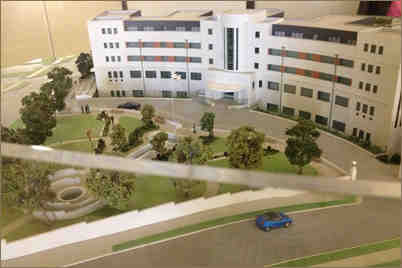
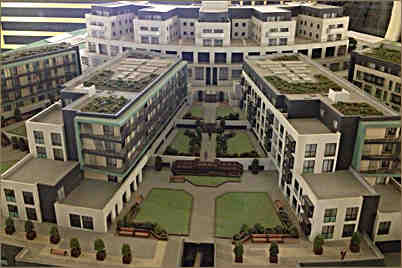
Is this the real deal? Yes and no - these are examples of a beautiful miniaturized model which has been displayed in the recently restored lobby of the former Ocean Hotel - my thanks to craftsinstitute.com for the find!
Page refreshed : 18th October 2019 (G)
